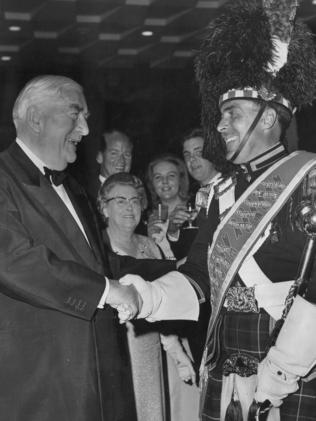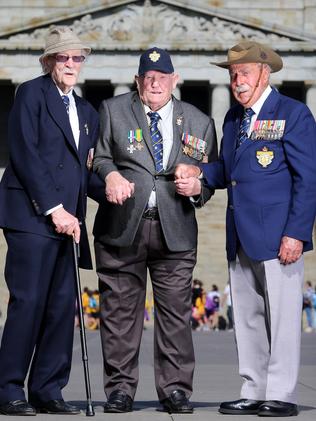Rat of Tobruk Bob Semple remembers tenacity of his fellow Aussies in famous WWII battle
BOB SEMPLE is 97 but the heroic Rat of Tobruk still treasures the friendships forged in the heat of one of World War II’s most famous battles.

Inner South
Don't miss out on the headlines from Inner South . Followed categories will be added to My News.
SITTING in the middle of Albert Park’s Tobruk House, amid photographs, maps and other war memorabilia, Bob Semple pauses while telling his story of heroism and mateship during World War II.
Mr Semple was one of the legendary Rats of Tobruk, the tenacious Aussies who for eight months held the Libyan port against the formidable Afrika Korps.
During a siege that became the longest in British military history, 14,000 Allied troops lived in dugouts and caves while withstanding Rommel’s daily artillery fire, tank attacks and bombings.
Mr Semple, 97, vividly recalls the desert’s searing heat and desolation, and the Aussie soldiers’ tenacity and determination.

“I hope you don’t think I’m trying to romance about this,” he told me.
Rather, he said, his strongest memories are of difficult conditions, almost overwhelming odds and scarce resources.
“Living in a hole in the ground does awful things ... and the challenge brings out that quality of mateship and will.
“The challenge goes out to your own flesh and blood,” he said.
“We were used to sharing things ... with one another, by necessity.
“And the spirit — I can only speak for my own troops and the Australian troops — without being egotistical, or without being patronising or anything else, but it was a special type of mateship.
“I’ve tried to measure this, and in areas the likes of the desert ... with no trees, consistent boiler conditions ... and mirages and dust storms, they were no playthings, I assure you.
“They were a great test to your mind.
“And you were on duty for 24 hours a day, there’s no beg pardons, and when the ‘go’ signal goes up, well, you’ve got to go.”
Mr Semple said it was almost automatic for Australians to want to help their mates.
“Their behaviour in the main was exceptional,” he said.

OFF TO FIGHT IN LIBYA
Mr Semple was just 20 years old when his unit, the 2/12 Australian Field Regiment, was called on to fight German troops in the Libyan port of Tobruk.
But the desert conditions and swarms of flies and fleas were a far cry from where his life began.
Born and educated in Essendon, Mr Semple left school to join the workforce when he was about 16, securing a job in the “rag trade” at a warehouse in Flinders Lane.
Yearning for adventure, Mr Semple and his mates decided to join the army around 1936, approaching the Victorian Scottish Regiment in South Melbourne.
“First the boss man at the depot in South Melbourne ... he said, ‘you’ve come to join the army? I’ve got news for you, get in the queue’,” Mr Semple recalled.
“So we had to get in the queue.
“And he said, ‘furthermore, you’ve got to buy your own kilt’.”


Scrimping and saving to pay for the kilt — which he still has today — Mr Semple gave everything a go, including learning to use a machine gun, horseriding and playing bagpipes in the regimental band.
“Along the way my grandfather thought it wouldn’t be a bad idea, seeing I came from (Scottish) stock, that I (learn) the bagpipes,” Mr Semple said.
“I got hold of a tutor and I started to learn the bagpipes and I learnt to ‘wrestle the octopus’.
“I stayed connected with it all my life.”
When war broke out, the regiment was called up, but not everyone was sent to battle.
“A number of us decided to blow through and go out to Caulfield Racecourse ... and we threw our hats in the middle and finished up being drafted to the artillery,” Mr Semple said.
Ultimately, after Allied fortunes went sour in Europe following Dunkirk, his unit was reformed again, this time into the 2/12 Field Regiment — and would see action as far afield as Tobruk and El Alamein.
A CHALLENGING METRIC
Shipped out to Palestine — the main holding area for most Australians in the Middle East — Mr Semple’s regiment waited to join the fight.
“Rommel was introduced to the Middle East with the Afrika Korps, which was probably the most efficient and up-to-date and best equipped unit in the world,” Mr Semple said.
“And they came and their equipment was so superior to ours ... and they chased the troops of ours and the British.
“We were retreating and they were chasing us.
“My unit was still in Palestine — with no guns.
“Digging holes and filling them in. Anyhow, General (Leslie) Morshead, he said, ‘there’ll be no surrender. We will hold this joint.’

“And most of our infantry battalions ... we did a left wheel into Tobruk.”
Lacking much of their own artillery, the soldiers at Tobruk were forced to rely on captured guns, and it was decided that Mr Semple’s unit would be sent in.
Moving at night to avoid the constant shelling by German troops, they were sent in by sea from Alexandria to Tobruk.
“We only had a few old guns in the fort ... when we got to Tobruk, they farmed this stuff out,” Mr Semple said.
“Well, the biggest problem we had there was these guns were in the metric system and we were educated in the imperial system.
“So therein was the fun and games.
“We had to present ourselves for our officers to do conversions.
“And we remained like that, of course, for a large part of the occupation and the siege.”
The landscape, the single water bottle per man per day and the searing 40 degree heat took a toll.
“Never in our wildest dreams did we think we would be involved in something quite like this,” Mr Semple said.
“When you compare it with WWI ... there were blokes that drowned in mud.
“But we were the opposite there in the desert.”
MATESHIP
Mr Semple said being on alert 24 hours a day, seven days a week for weeks on end in such extreme conditions wore people down.
“I find them exceptional, and I’ve never met the likes of them,” he said.
“And they are friendships that are with me today — as strong as they ever were.
“Mateship of that depth, all the crown jewels in the world will never buy that.”
Today, Mr Semple is the president of the Victorian Rats of Tobruk Association, the only Tobruk organisation in the country to buy a property for themselves.
He said the hall in Albert Park still enjoyed a reputation as being “a unique place”.
“It has a special character because of the people that have been through it,” Mr Semple said.
More than that, it’s a tribute to those who served.



